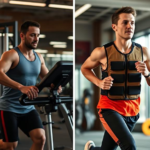
While both weighted vests and robotic exoskeletons are wearable devices intended to affect human movement, they function on fundamentally opposing principles. A weighted vest increases the load on the user’s body to intensify a workout, while an exoskeleton uses motorized assistance to reduce physical strain and augment the user’s capabilities. The choice between these two depends entirely on a person’s goal: resistance training to build strength and endurance or powered assistance for rehabilitation, daily activities, or specialized tasks.
Weighted vests: Training through resistance
A weighted vest is a form-fitting garment with pockets to add or remove weighted plates, typically ranging from a few to over 40 pounds. By increasing the total load on the body, it boosts the intensity of a workout, forcing the user’s muscles and cardiovascular system to work harder.
How it works
- Increases metabolic demand: The additional weight forces the body to burn more calories and increases the heart rate and oxygen intake, which is beneficial for cardiovascular health and weight management.
- Boosts strength and endurance: Training with a weighted vest forces the body to adapt to a heavier load. When the vest is removed, the user feels lighter and more agile, with improved speed and endurance.
- Enhances bone density: The added stress from the vest stimulates bone growth, which is particularly beneficial for low-impact exercises like walking and can help counteract bone loss in older adults.
- Engages core muscles: The core is forced to work harder to stabilize the torso, which can improve posture and overall spinal stability.
- Combines strength and endurance: Activities like “rucking”—walking with a weighted pack or vest—combine cardiovascular and resistance training, offering a time-efficient full-body workout.
Drawbacks
- Higher impact on joints: Running or jumping with a weighted vest increases compressive forces on joints like the knees, hips, and lower back, significantly raising the risk of injury.
- Risk of muscle strain: Users who start with too much weight can easily strain muscles and joints. It is recommended to start with a vest weighing only 5–10% of your body weight.
- Not for all users: Individuals with pre-existing injuries or certain health conditions should be cautious and consult a doctor before use, as the added stress could exacerbate their issues.
- Not a long-term solution: To be used safely, weighted vests should be worn for limited durations during training and not for extended daily use.
Robotic exoskeletons: Enhancing through augmentation
Robotic exoskeletons, particularly those for the lower limbs, are battery-powered, wearable robotic systems designed to assist movement and reduce the user’s metabolic effort. Sensors and actuators move in sync with the user, providing powered assistance at key points in the gait cycle.
Here’s a summary of the key companies and products:
| Company | Product/Application | Description |
|---|---|---|
| Kenqing Technology | π (Pi) Sports Assist | Lightweight (1.8 kg) exoskeleton with AI algorithms providing synchronized assistance for walking and hiking. Tested successfully on Mount Tai, making climbing easier for tourists, including the elderly and those with limited mobility. Also offers the Q20 industrial exoskeleton for lumbar support. |
| Hypershell | Hypershell X Series | An intelligent wearable exoskeleton using AI to learn movements and provide adaptive power assistance, reducing perceived effort during activities like hiking and running. It is designed to be lightweight and comfortable for long durations. |
| Fourier Intelligence | X2 Exoskeleton & others | Develops robot-enabled prostheses and exoskeletons for rehabilitation, assisting individuals with neurological disorders and spinal cord injuries. The X1 model is expected to be more affordable than some foreign models. The company also makes robots for arm, wrist, and ankle rehabilitation. |
| Dnsys X1 | Exoskeleton | Released an exoskeleton earlier this year claiming to reduce quad energy expenditure by 30 percent and lower heart rate. |
| RoboCT Technological Development | Exoskeleton for paralyzed patients | Developed an exoskeleton simulating human stride to help paralyzed patients walk again. |
How it works
- Reduces metabolic cost: Exoskeletons use motors and sophisticated algorithms to provide torque and reduce the energy needed for walking or hiking, making movement feel less strenuous.
- Promotes rehabilitation: In medical settings, exoskeletons assist patients with neurological injuries, like strokes or spinal cord injuries, to regain or relearn walking. The robotic assistance provides controlled, repetitive movements to rebuild neural pathways.
- Assists with specific tasks: Exoskeletons can be tailored to augment specific tasks, from helping workers lift heavy loads to boosting endurance for hikers.
- Provides real-time feedback: Advanced systems collect data on the user’s movement, providing valuable insights for physical therapists to refine treatment plans.
- Offers modular and customizable designs: Newer, lightweight exoskeletons like the Hypershell X offer adaptive power assistance that learns the user’s movements, providing seamless support across different terrains.
Drawbacks
- High cost: Medical-grade and advanced commercial exoskeletons are still prohibitively expensive and not widely accessible.
- Power and weight limitations: Powered exoskeletons rely on batteries, which add weight and have limited charge durations. The balance between battery life and total device weight remains a key design challenge.
- Limited availability for daily use: Many exoskeletons are still in the developmental or rehabilitative stages and are not yet optimized for everyday consumer use.
- Risk of pressure injuries: For medical patients with limited sensation, the straps and interface points can lead to pressure injuries, requiring careful monitoring.
Comparison infographics
| Weighted Vests | Robotic Exoskeletons | |
|---|---|---|
| Primary Goal | Training and Resistance: Increases workout intensity to build strength and endurance. | Assistance and Augmentation: Reduces physical strain and improves mobility for rehabilitation, industrial, or recreational purposes. |
| Technology | Passive/Low-Tech: A simple, non-powered garment that holds weights. | Active/High-Tech: Powered motors and sensors provide real-time assistance based on movement. |
| Energy | Uses Human Energy: Forces the user to expend more energy to carry the extra load. | Uses External Power: Reduces the user’s energy expenditure by providing motorized assistance. |
| Cost | Inexpensive: Widely available and affordable, with prices typically ranging from $50–$200. | Expensive: Costs can range from tens to hundreds of thousands of dollars, depending on the model and application. |
| Risk of Injury | Moderate: Increases joint impact, potentially leading to injuries if not used properly. | Low (for appropriate users): Can reduce injury risk by taking on the strain of heavy lifting or repetitive tasks. |
| Rehabilitation Use | Limited/Supplemental: Used to enhance strength in later stages of recovery. | Primary/Early Stage: Used to actively assist and retrain movement patterns for neurological or spinal cord injuries. |
| Endurance | Develops Endurance: Training with the extra weight builds stamina. | Augments Endurance: Allows a user to perform tasks for longer by reducing fatigue. |
| Complexity | Very Simple: Easy to use with minimal instruction. | Very Complex: Requires training to operate safely and effectively. |
| Power Source | N/A | Battery-Powered: Requires regular charging and has limited operational time per charge. |
Which technology is right for you?
Choosing between a weighted vest and a robotic exoskeleton depends entirely on a person’s individual needs and goals.
Choose a weighted vest if you:
- Want to increase the intensity of your current workouts, like walking, hiking, or running.
- Are looking for a low-cost, low-tech way to build strength and endurance.
- Do not have pre-existing joint or mobility issues that would be exacerbated by added load.
- Want to incorporate resistance training without needing a gym or heavy equipment.
Choose a robotic exoskeleton if you:
- Are a patient recovering from a neurological or spinal cord injury and need assistance with walking.
- Work in an industrial setting and need to reduce fatigue or injury risk from heavy lifting or repetitive tasks.
- Are a recreational enthusiast looking to significantly boost endurance for long-distance hiking or other outdoor activities.
- Have the financial means to access a specialized, high-tech device.
Conclusion
The evolution of wearable technology offers a spectrum of solutions for human mobility. At one end, the simple, effective weighted vest uses the principle of resistance to make the body stronger. At the other, the sophisticated, motorized robotic exoskeleton leverages power and algorithms to make the body’s movements more efficient. As exoskeleton technology continues to advance, becoming lighter, more affordable, and more widely available, the line between these two approaches may blur, but their core purposes will remain distinct: resistance versus assistance.
Frequently asked questions: exoskeletons vs weighted vests
How do I choose between a weighted vest and an exoskeleton?
The choice depends on your objective. A weighted vest is a low-cost tool for intensifying workouts to build strength, while an exoskeleton is an expensive, high-tech device for assisting movement to reduce fatigue or aid rehabilitation.
Is running with a weighted vest safe?
It is not recommended for everyone. While it can enhance fitness, it increases stress on your joints, particularly if you have pre-existing conditions. It’s crucial to start with light weight (5–10% of body weight), use a vest designed for running, and avoid overuse.
How long do exoskeleton batteries last?
Battery life varies significantly by model, manufacturer, user weight, and terrain. High-end industrial exoskeletons can operate for up to eight hours on a single charge. Lightweight consumer models like Hypershell’s may provide enough power for a long hike.
Are exoskeletons only for people with disabilities?
No. While medical exoskeletons are vital for rehabilitation, industrial models are used to prevent worker injuries, and consumer versions are designed to enhance mobility for outdoor activities like hiking and running.
How much do exoskeletons cost?
The price can range dramatically. Basic passive or unpowered exoskeletons for industrial use may cost a few thousand dollars. Lightweight consumer models can be a few thousand. Medical-grade devices for rehabilitation can cost over $100,000.
Can wearing an exoskeleton make me stronger?
An exoskeleton will not build muscle mass on its own like a weighted vest would. Instead, it amplifies the wearer’s strength and endurance by reducing the effort needed to move, allowing you to perform tasks for longer periods with less fatigue.
Is a weighted vest better than ankle weights?
For most activities, a weighted vest is safer than ankle weights because it distributes the load evenly across your torso. Ankle weights can alter your gait and lead to joint and muscle imbalances.
Is a license required to use an exoskeleton?
A license is not required for consumer exoskeletons. However, medical and industrial models used in professional settings often require certification and user training.



